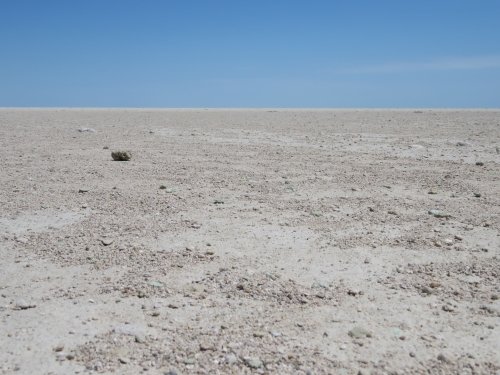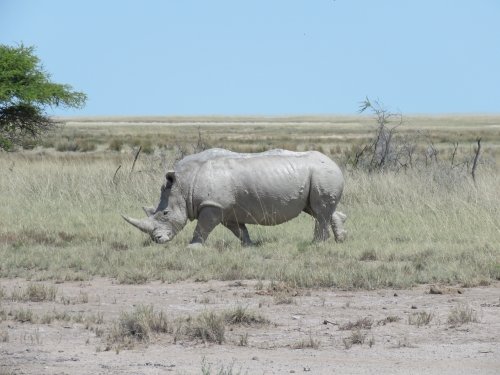Els Slots
Etosha Pan
The Etosha Pan in northern Namibia is one of the world’s largest salt pans. It is a former lake bed of 4,730 square km. Nowadays the area is mostly a dry, saline and uninhabited desert. This combined with the high temperatures results in the fact that no flora or fauna to speak of can survive there. Only ostriches sometimes seek shelter here from predators. Vehicular traffic on the pan itself is forbidden.

On the fringes of the pan there are natural (and artificial) waterholes, grasses and shrublands that support high numbers of mammal and bird species. They are protected within the Etosha National Park, which with a founding date of 1907 is one of the oldest conservation sites in Africa.
The park has the largest single population of black rhino in the world. Numbers are nowadays undisclosed to prevent unwanted attention of poachers (drones are forbidden in the park for the same reason). But earlier numbers indicate about 600-750 black rhino living in Etosha. We saw about 10 of them. White rhino has been reintroduced here as well, but they are more rare. We were lucky to encounter one formidable individual at the edge of the pan, and follow him around for some 20 minutes. He took a long mud bath, so he was one big clay-ey, shiny mess. Afterwards he crossed the road close to our truck, and disappeared into the bushes – not before giving his nose/horn a long rub against a tree.

We spent 3 days in Etosha National Park, crossing it from east to west. We slept two nights in lodges inside the park, in Namutomi and Okakuejo. These and the other park lodges/restaurants/camps get fairly busy. They are not as luxurious as the private lodges where we had stayed at outside the park, but do a fair job especially at dinner time. The main attractions of the park lodges are their private waterholes, at which animals come to drink during day and night. Most famous is the one at Okaukuejo. There are benches and a small stand to sit and watch the comings and goings from a safe distance. It’s like watching a nature documentary on TV together with a lot of other people. After sunset rhino will surely show up – within the course of an hour I saw 4 individuals, including a mother with a very young calf.
Other good sightings during the game drives included: a hyena den with 3 or 4 cute baby hyena, 3 cheetahs guarding a kill and a family of 5 lions avoiding the heat under the biggest tree in the area. Also we visited two great waterholes in the west of the park, that hasn’t been opened to tourists for long. At the Ozonjuitji M’bari and Sonderkop waterholes we saw the congregation of animals that Etosha is so famous for. At the first we saw an elephant share his bath with hundreds of zebra’s, springbok and wildebeest. At the second, giraffes were drinking (always a spectacular sight) with numerous red hartebeest and rows of zebra joining. Three lions were watching them lazily from under a bush, they probably already had their stomachs full.

Etosha is undoubtedly one of the best national parks in southern Africa, both for its conservation track record and visitor experience. I do agree with Namibia’s reasoning in its description of the tentative site that “although large African savannah fauna has already been inscribed elsewhere, some of Etosha’s fauna species are under threat or have died out elsewhere”. It’s especially a good rhino habitat. For a possible future WH nomination, a transboundary serial nomination with the Makgadikgadi Pans in Botswana is considered.
More on
Els SlotsComments
No comments yet.
